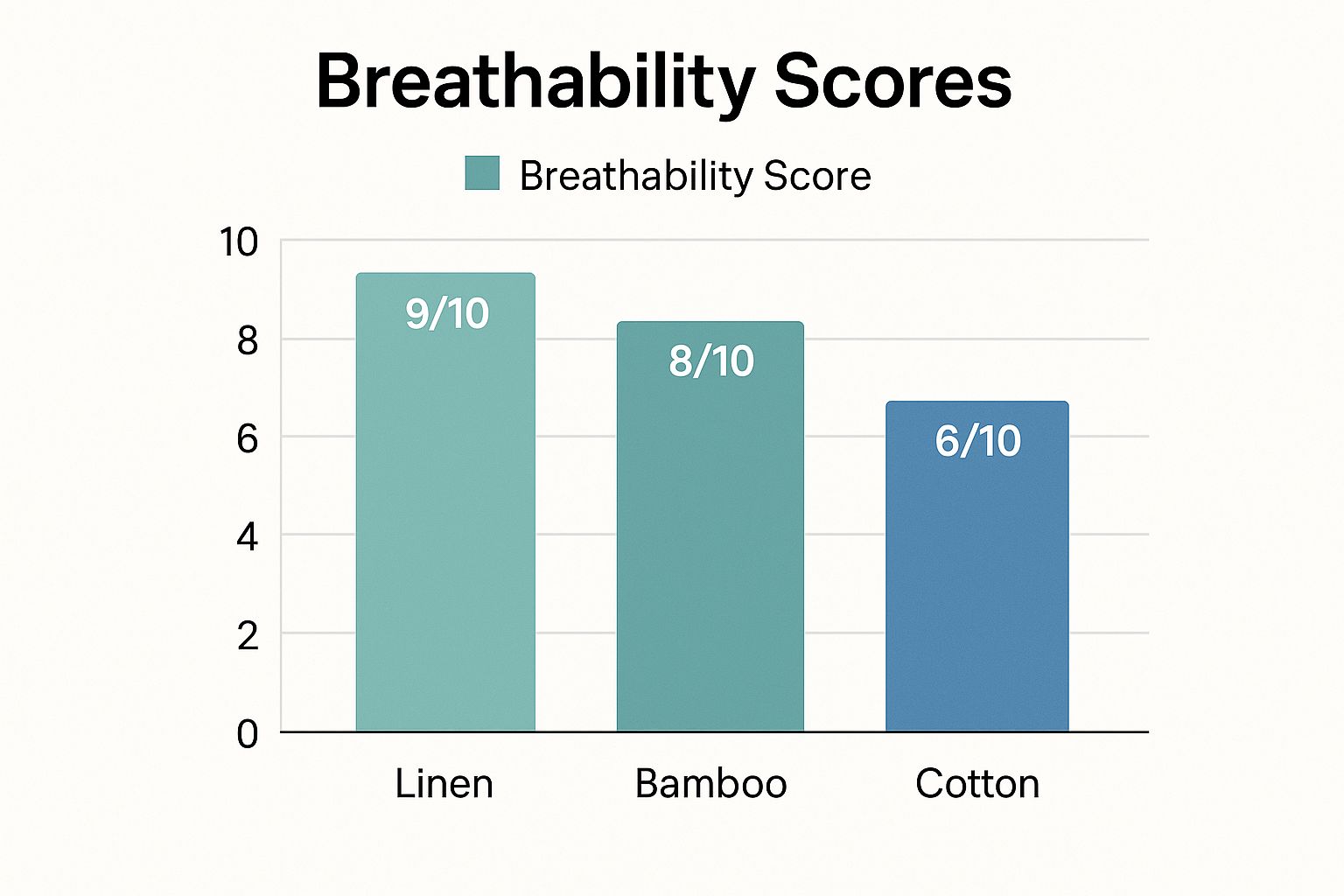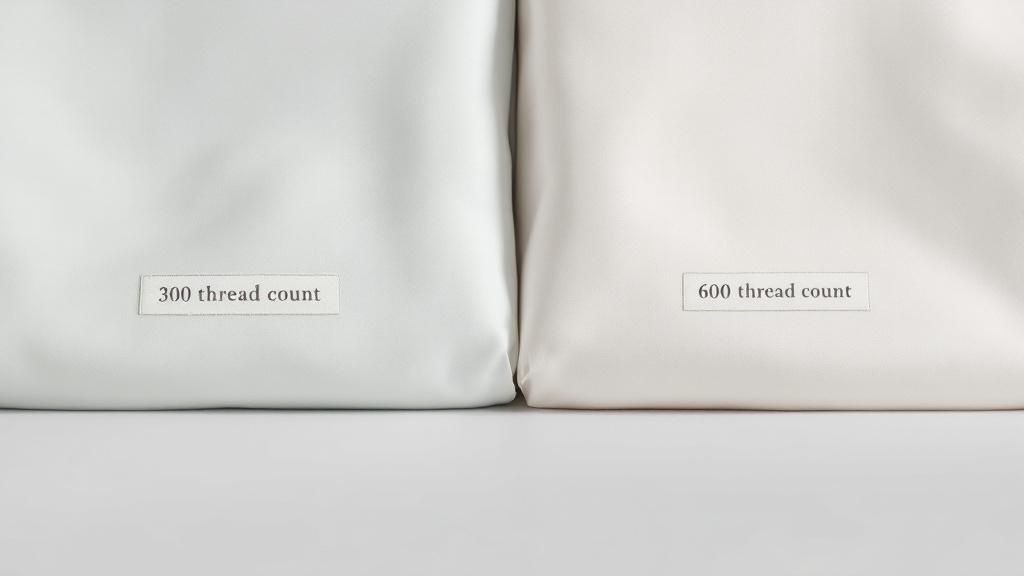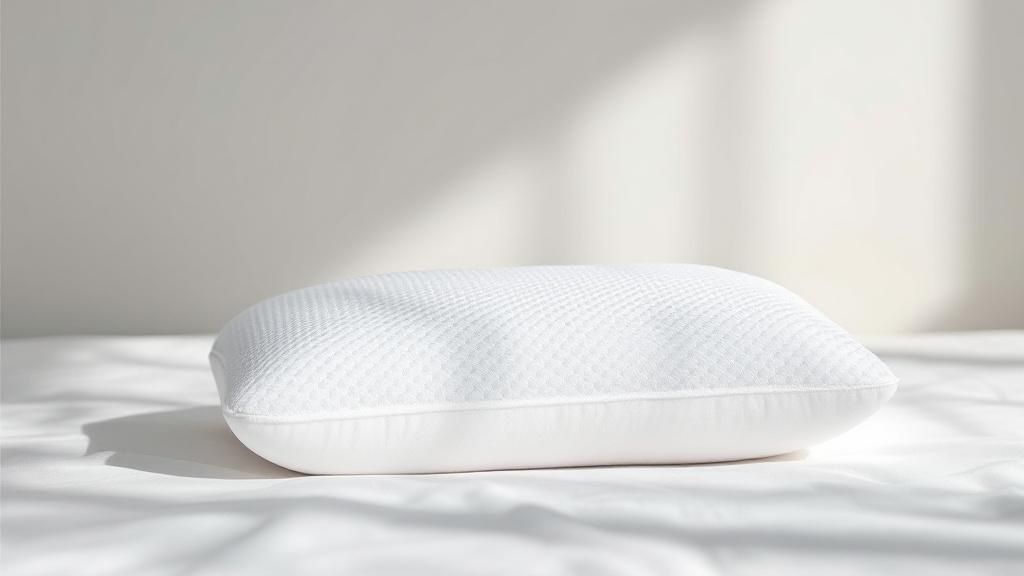If you're waking up in a sweat, there's a good chance your bedding is the culprit. The best bedding for hot sleepers really comes down to two things: breathability and moisture-wicking. It's all about finding fabrics that let air move around and pull sweat away from your skin, so you don't wake up feeling clammy and gross.
Why Your Bedding Is Making You Overheat

It’s a familiar, frustrating story. You climb into bed feeling perfectly fine, but a few hours later, you're kicking off damp, tangled sheets. This usually happens because of how your bedding handles your body's own thermostat. All night long, your body naturally gives off heat and moisture. If your bedding traps it all, you end up with a personal sauna right under the covers.
The Science of Trapped Heat
Think about fabrics like polyester. They're essentially tightly woven plastic fibers that block airflow. As your body heat builds up, it has nowhere to escape. This trapped warmth cranks up the humidity under the duvet, which is a direct cause of night sweats and a terrible night's sleep.
This isn't just an issue of being uncomfortable—it directly impacts your sleep quality. When your body is constantly fighting to cool itself down, it can't sink into the deep, restorative sleep stages it needs.
Your bedding should work with your body, not against it. The goal is to create a stable microclimate that supports consistent, deep sleep without constant temperature fluctuations.
People are catching on to how much sleep affects overall health, and it's driving huge market growth. The global home bedding market was valued at USD 112.6 billion and is on track to nearly double by 2034. A big part of that boom is consumers looking for better heat dissipation and moisture control. You can discover more insights about home bedding market trends and see how they’re shaping new products.
What Makes Bedding Cooling
So, what should you actually be looking for? It all comes down to the fabric's structure and natural properties. Bedding that genuinely works for hot sleepers will have these features:
- High Breathability: Look for materials with a looser, more open weave. This lets air circulate and prevents heat from getting trapped in the first place.
- Moisture-Wicking: You need fabrics that actively pull moisture away from your skin and move it to the surface of the sheet. From there, it can evaporate quickly, keeping you dry.
- Temperature Regulation: Natural fibers are often fantastic at this. They adapt to your body, helping you stay warm enough without ever crossing the line into overheating.
Choosing the Best Cooling Bedding Fabrics
Walking down the bedding aisle can feel like a guessing game, especially when you're desperate for a cooler night's sleep. Every package seems to promise the same thing, but the real secret to staying cool isn't in fancy marketing—it's woven right into the fabric itself. The two things that matter most are breathability (how well air flows through) and moisture management (how well it handles sweat).
It's all about the fiber and the weave. For example, not all cotton is created equal. Long-staple cottons, like Pima or Egyptian, have longer fibers that create a smoother, stronger yarn. This allows for a lighter percale weave that lets air circulate freely, so your body heat doesn't get trapped under the covers.
Natural vs. Synthetic Fibers: The Clear Winner for Hot Sleepers
When it comes to staying cool, I almost always point people toward natural fibers. Think about it: materials that come from plants are naturally designed to move water, and that same quality makes them fantastic for bedding.
Take linen, for instance. It's made from the flax plant and has a naturally open, almost porous structure. This makes it one of the most breathable fabrics you can find. It doesn't cling to your skin, allowing air to move around you, which is a lifesaver in hot, humid weather.
Bamboo-based fabrics are another standout. They are incredible at wicking moisture away from your skin, absorbing a surprising amount of sweat before they even start to feel damp. This helps you stay dry and comfortable all night. If you’re looking for a sustainable option, it's worth exploring how bamboo sheets offer a cool choice for hot sleepers.
One of the biggest mistakes hot sleepers make is falling for the "softness" trap. Ultra-soft synthetic fabrics like polyester and microfiber might feel nice at first, but they essentially act like a plastic sheet, trapping heat and moisture. You're almost guaranteed a sweaty, uncomfortable night.
The difference in airflow between fabrics isn't just a minor detail; it's significant.

As you can see, natural fibers like linen and bamboo are the clear front-runners for letting air pass through, which is the cornerstone of staying cool while you sleep.
Comparing Cooling Bedding Fabrics
To make your decision easier, it helps to see how the top contenders stack up against each other. This table breaks down the key characteristics of popular cooling fabrics.
| Fabric | Breathability | Moisture-Wicking | Feel | Care Difficulty |
|---|---|---|---|---|
| Linen | Excellent | Good | Crisp, textured, softens over time | Moderate (prone to wrinkles) |
| Bamboo | Very Good | Excellent | Silky, smooth, drapes well | Easy to Moderate (gentle cycles) |
| TENCEL™ | Very Good | Excellent | Cool-to-the-touch, smooth | Easy to Moderate (gentle cycles) |
| Cotton (Percale) | Good | Moderate | Crisp, cool, classic | Easy |
| Microfiber | Poor | Poor | Very soft, can feel clingy | Very Easy |
Ultimately, the best choice depends on what you value most—the unmatched airflow of linen, the silky feel of bamboo, or the crispness of a good percale cotton sheet.
Key Cooling Fabric Options to Look For
To cut through the noise, here are the materials I consistently recommend to clients who sleep hot.
- Linen: This is the champion of breathability. It's incredibly durable and gets softer with every wash. Its natural texture keeps the fabric slightly off your skin, promoting airflow.
- Bamboo Viscose: Famous for its silky-smooth feel and top-tier moisture-wicking abilities. It’s also hypoallergenic, making it a great choice for those with sensitive skin.
- TENCEL™ Lyocell: Another powerhouse plant-based fiber, TENCEL™ is known for feeling cool to the touch right out of the package and has an eco-friendly production process.
- Long-Staple Cotton: If you love that classic hotel-sheet feel, look for a percale weave with a thread count between 200 and 400. This combination delivers a crisp, cool, and highly breathable sheet.
Building Your Complete Cooling Sleep System

The right sheets are a fantastic starting point, but if you’re serious about winning the war against night sweats, you need to think bigger. I like to think of a bed as a complete sleep ecosystem. Every single layer, from what's on your mattress all the way up to your pillow, plays a part in keeping you comfortable.
It's a classic mistake: you invest in great sheets, but a single heat-trapping layer underneath sabotages the whole setup. Think about that standard mattress protector you might be using. Many are made with waterproof, plastic-like materials that completely kill airflow, creating a sweaty barrier between you and your otherwise cool mattress. Look for a protector made from breathable, moisture-wicking fabrics like TENCEL™ or bamboo to keep that air moving.
Layering for Adjustable Comfort
One of the most effective changes you can make is to ditch the thick, heavy duvet. It's an "all-or-nothing" situation that leaves no room for your body's temperature shifts during the night. A much smarter approach is to use several lightweight layers.
Here are a couple of layering combinations I’ve found work wonders:
- Crisp Top Sheet and a Lightweight Quilt: This is a simple but effective duo. You get two distinct levels of warmth that you can easily add or peel back as needed.
- Breathable Comforter and Duvet Cover: If you can't part with the fluffy feel of a comforter, just choose wisely. Look for one filled with a naturally thermoregulating material like lightweight wool or silk. Then, wrap it in a linen or bamboo duvet cover to let it breathe. Our https://bamtekhome.com/blogs/cooling-bed-sheets is the perfect place to start for finding that ideal base layer.
This strategy gives you the control to fine-tune your comfort, ensuring you stay in that sweet spot for sleep all night long.
Pro Tip: A personal favorite pairing for hot sleepers is a set of crisp percale sheets with a lightweight, wool-filled comforter. Wool is an incredible temperature regulator—it pulls moisture away from your skin and breathes exceptionally well, keeping you dry and comfortable without making you overheat.
Don't Forget Your Pillow and Room
Your head and neck are major heat-release zones, so what’s under your head matters just as much as what's under your body. A solid block of memory foam can often feel like a heat sink, absorbing and trapping warmth all night.
Instead, check out pillows filled with materials designed for airflow, like shredded latex, buckwheat hulls, or newer cooling gel foams.
Finally, look beyond the bed itself. Your bedding is crucial, but the room's environment is the final piece of the puzzle. Simply improving the airflow in your bedroom can make a massive difference. Understanding the role of home ventilation is a powerful step toward creating your ultimate cool and comfortable sleep sanctuary.
Little Changes That Make a Big Difference on Hot Nights
While finding the perfect bedding is a game-changer for hot sleepers, your daily habits and environment play an equally crucial role. Think of it as a total strategy—you have to cool down your room and your body, not just your bed. Making a few smart tweaks to your evening routine can support your body's natural cooling process and set the stage for a much more comfortable night.
Let's start with your bedroom's climate. I've found that getting the temperature just right is the foundation for everything else. Sleep experts consistently recommend keeping your bedroom between 60 and 67°F (15 to 19°C). When your room is in this range, it sends a clear signal to your body that it's time to power down and rest, helping you fall asleep faster and stay cool.
It’s not just about the temperature, though. Humidity is the unsung villain of hot nights. High humidity makes the air feel heavy and sticky, which hampers your body's ability to cool itself by evaporating sweat. Properly controlling humidity levels in your home can make a 70-degree room feel far more comfortable than a 65-degree room with soupy air.
Pre-Bedtime Rituals to Beat the Heat
You can actively lower your body temperature before your head even hits the pillow. I always suggest integrating a few of these simple habits into your evening wind-down.
-
Take a Warm (Not Hot) Shower: It sounds counterintuitive, but a lukewarm or warm shower an hour or so before bed is perfect. As the water evaporates from your skin, it cools you down, lowering your core body temperature. Just be sure to avoid a steaming hot shower, which can raise your temperature instead.
-
Dress the Part: This is not the time for flannel pajamas. Instead, go for sleepwear that's lightweight, loose, and made from breathable fabrics like cotton, bamboo, or TENCEL™. Better yet, sleep in the nude!
-
Rethink Your Nightcap and Snack: That late-night spicy meal or glass of wine might be comforting, but they can also fire up your metabolism. This metabolic boost generates internal heat, making it harder to cool down. Try to have your last big meal at least two to three hours before bedtime.
I see people make this mistake all the time: they spend a fortune on cooling sheets but ignore their environment and habits. The secret to finally sleeping cool is a holistic approach. When you combine the right bedding with a cool room and body-conscious routines, you create a complete system for deep, uninterrupted rest.
How to Be a Smarter Bedding Shopper

It seems like every bedding brand out there is promising to keep you cool at night. It's no surprise, given the global home bedding market is a booming USD 104.64 billion industry. The demand is massive, especially in hotter climates like the Asia Pacific region, which makes up a staggering 37.3% of the market. You can dive deeper into the numbers by checking out the full research on the bedding market to see how these trends shape what you find in stores.
For hot sleepers, this explosion of choice is both a blessing and a curse. More options are great, but it also means you have to sift through a lot more marketing hype. To really find what works, you need to become a smarter shopper and learn to look past the pretty packaging and right to the label.
Decode the Label Like a Pro
I've learned from years of experience that the secret to genuinely cool bedding isn't a sky-high thread count or a vague "cool-touch" claim. It all comes down to two things: the fabric's composition and its weave. These two elements are what truly determine how breathable and moisture-wicking your sheets will be.
Instead of getting distracted by buzzwords, here's what you should actually be looking for:
- Fabric Composition: Your best bet is always 100% natural fibers. Think linen, bamboo, or high-quality long-staple cotton. Steer clear of any blends that include polyester—even a small percentage can trap heat and make you sweat.
- Weave Type: The weave is just as critical as the material. A percale weave is ideal for hot sleepers because it creates a crisp, grid-like fabric with plenty of space for air to circulate. On the other hand, a sateen weave is much tighter and denser, which feels silky but ultimately traps heat and limits breathability.
Forget about thread count being the most important factor. A 300-thread-count percale sheet will almost always sleep cooler than an 800-thread-count sateen one simply because its open weave allows for far better airflow.
Once you know to focus on these specifics, you can confidently choose bedding for hot sleepers that actually works. Armed with this knowledge, you can invest your money wisely in sheets that will genuinely improve your sleep quality night after night.
Common Questions About Cooling Bedding
Diving into the world of cooling bedding can feel a little overwhelming. With so many different materials and marketing terms flying around, it's tough to know what actually works and what's just hype. Let's tackle some of the most common questions I hear from people trying to get a cooler night's sleep.
One of the biggest misconceptions is about thread count. For years, we've been told that a higher number means better quality. But for hot sleepers, that's simply not the case. A super-high thread count—we're talking over 500—means the weave is incredibly dense. While it might feel smooth, it traps a ton of heat and stops air from flowing.
Instead of chasing high numbers, look for a sweet spot. A thread count between 200 and 400 in a percale weave is usually the perfect balance. This creates a fabric that’s crisp, light, and lets air circulate, which makes a world of difference compared to a heavy, heat-trapping sateen sheet.
Answering Your Top Concerns
It makes sense to have a few specific questions before you invest in better sleep. Here are some straightforward answers to the things people ask us most often.
Is a cooling mattress topper really worth it?
Yes, it absolutely can be. If you suspect your mattress is the main culprit for trapping heat (which is common with memory foam), a good topper is a game-changer. It acts as a breathable barrier between you and the mattress. Look for one made from gel-infused foam, natural latex, or even wool. It's a much more affordable solution than buying a whole new mattress.
How do I take care of delicate fabrics like bamboo or linen?
Proper care is key to making sure these fabrics keep their cooling magic. Always wash them in cold water on a gentle cycle. When it's time to dry, either tumble dry on the lowest heat setting or—even better—let them line dry. Stay away from high heat and fabric softeners, as they can break down the natural fibers and hurt their breathability over time. For those dealing with night sweats, these fabrics are a lifesaver. You can find more details in our guide to the best sheets for hot flashes.
You might think wool is just for keeping warm in the winter, but that’s a common myth. Lightweight wool is actually an incredible temperature regulator. It’s surprisingly breathable and fantastic at wicking moisture away, keeping you comfortably dry whether it’s cool or warm.
When it comes down to it, the best bedding for you will tackle both breathability and moisture control. Once you understand how these pieces work together, you can finally build a sleep setup that ends those sweaty, restless nights for good.
Ready to feel the difference that cool, silky 100% organic bamboo can make? Explore the Bamtek Home collection and see how the right bedding can completely transform your sleep. Shop our premium bamboo bedding today!










